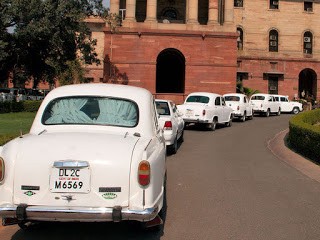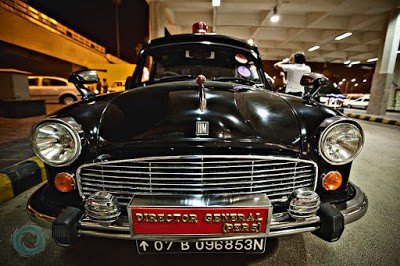# Ambassador Car — The King Of Indian Roads
Born from the Morris Oxford III and built in the United Kingdom, operations were brought to India in the mid 1950’s by Hindustan Motors. And although the car is etched in British style, Indians embraced the vehicle from inception due to the size, comfort and ride afforded it’s passengers. Through the years the name has undergone minor changes, most notably as Mark I, II, III and IV, but today it’s simply sold as the Ambassador.( )
)
The car initially came with a side-valve engine but was later improved to an overhead-valve engine. After this there were just minor and easily manageable hiccups.
In 1957 all the tooling of the British Morris Oxford Series III was transferred to India. The car was renamed the Ambassador and series-production started in 1957. The first model was named Mark-1. In 1962 the Ambassador underwent frontal face lift with a closely chequered grill. The interiors now had a redesigned Dash-board and instrument cluster. The early mica sheet was replaced by wood grain coated plywood and aluminium bezel. This model was named as Ambassador Mark II.
Being one of the ubiquitous early model of Ambassador numerous older versions can be found in restoration, garages and in numerous India movies of that era. In its final years in 1977 it had no competition other than Premier Padmini and its smaller rival Standard Motors almost ceased its early models. In 1977 the Mark 3 version was launched with another frontal face lift. The front grill had horizontal louvers giving it a modern feel and a round profile indicator lamp now isolated from the grill.At the rear a more modern looking number plate bezel replaced the early design which was commonly used by many other British cars as well.In 1979 the Ambassadors front went through a major facelift departing from a flatter design of 50’s which was retained till its end in 2014. The front grill was much smaller in height with a larger chequered grill and square ark lamps. Now a separate amber indicator lamps was incorporated on the semi front lip spoiler below the bumper. This model was named as Mark 4. In addition to the existing petrol version, a diesel variant was launched which was powered by a 1,489 cc, 37 bhp BMC B-series diesel engine. It was the first diesel car in India and was well received which was replaced by Nova version.
Current generation after the millennium renovation project at the Uttarpara Plant, the Ambassador was re-engineered and renamed the Ambassador Classic. The new model featured a redesigned dashboard, polyurethane seats, pull type door handles and the steering column gear lever was replaced by floor shift gears and had a tweaked up suspension. The higher end models featured servo assisted disc brakes and power assisted TRW steering. And then classic followed by Grand, Avigo, Encore with few changes like air conditioning, audio system and optional sunroof.
Today’s political elite have moved on to western luxury car brands, but tourists, travelers and locals can still catch a ride in the spacious backseats rolling the streets as taxis.( )
)
India’s Army has had a long affection to the strong performance of the Ambassador, specifically it’s ability to handle the tough terrain of Indian roads.
A visit to India isn’t complete without a ride in the backseat of an Ambassador. Five star hotels are generally stocked with waiting drivers and their counterpart vehicles.
Sale of Ambassador taxis had been banned since 1 April 2011, a year after BS IV emission standards were rolled out in 11 Indian cities, including Kolkata. At present the company is in an extremely challenging situation with plummeting sales and loss of Rs 29.96 crore in 2011–12. The company could only sell around 2,500 cars in 2011.
However, Hindustan Motors have recently started to fit the cars with a new, cleaner diesel engine, that complies with the new emission rules; and has now been able to resume taxi service in cities such as Kolkata, one of the cities in which it was banned. But the company only sold 2,200 Ambassadors in the financial year which ended in March 2014. Hindustan Motors blamed the shutdown on “worsening conditions at its Uttarpara plant which include very low productivity, growing indiscipline, critical shortage of funds, lack of demand for its core product the Ambassador and large accumulation of liabilities”. The company had stopped paying wages to workers a few months back and has finally stopped production on 25 May 2014.
Congratulations @vjn303, you have decided to take the next big step with your first post! The Steem Network Team wishes you a great time among this awesome community.
The proven road to boost your personal success in this amazing Steem Network
Do you already know that awesome content will get great profits by following these simple steps, that have been worked out by experts?